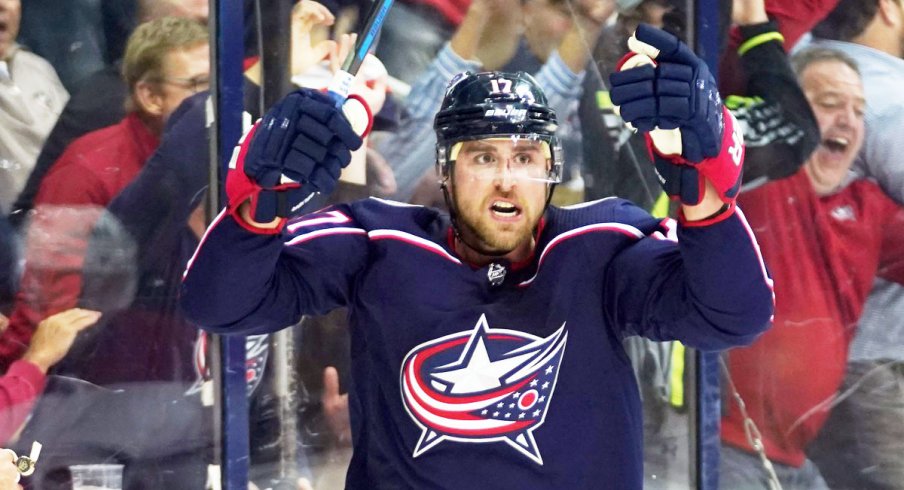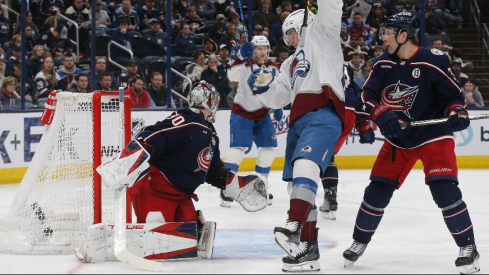Columbus Blue Jackets GM Jarmo Kekalainen is a busy man. With a first-round playoff series coming up, he’s only going to get busier this week. But here’s a hypothetical: what if, in the time between now and Wednesday’s series-opening matchup with the Tampa Bay Lightning, he discovered the secret to time travel?
That's right, we said time travel.
Let’s say that, by a complete freak accident, Kekalainen somehow cracks the secrets of the space-time continuum. Being as ruthless and competitive as he is – and knowing that orchestrating a first-round upset over the Tampa Bay Lightning would make him a legend – he decides to keep this a secret. He orchestrates a plan to use this technology to help the team win a Stanley Cup this year.
Let's set some ground rules:
- Kekalainen has to use this technology to help the Blue Jackets win a Stanley Cup
- He has to pull off his plan in a way that won’t be detected by the National Hockey League.
- Anything he does in the past doesn’t affect the current timeline, somehow.
- He can’t technically *add* a player to the roster, per the league’s rules.
- The mission here is to improve the Jackets, not to sabotage.
- He only gets one shot at this.
This, of course, leaves one solution: go back in time and grab a past version of a current Blue Jackets player to take their place in the current timeline. That way, he’s not *adding* a player, just replacing one guy on the roster with a younger version of that same guy.
It’s a foolproof plan. Now, all he has to do is pick a player to bring back to the future. Which player would you pick? Here are some standout options:
Brandon Dubinsky, 2013-14
This may be the safest choice here. Dubinsky, who turns 33 in just a few short weeks, is a shell of his former self. At his peak, though, he was the ideal playoff piece. In his second season with the Blue Jackets, Dubinsky was a productive offensive player, a shutdown defensive pivot and one of the game’s best agitators rolled into one.
The 2013-14 season may have been Dubinsky’s finest. He was all over the scoresheet in the regular season (16-34–50 and 98 penalty minutes in 76 games) and took his game to another level in the playoffs, causing havoc and giving Sidney Crosby a headache while putting up a 1-5-6 line in that six-game series.
That goal was a memorable one, too. Roll the tape!
Dubinsky’s never been a burner, but it’s clear that his speed and skill today aren't anywhere near where they were five years ago. The 2013-14 version of Dubinsky wouldn’t just be able to keep up with the modern-day Jackets, but he could add a viable shutdown line against a loaded Tampa Bay attack, while bringing some offense and playing up in the lineup.
Going from 2019 Dubinsky to 2014 Dubinsky would be a massive upgrade, and may be Kekalainen’s first instinct. The only problem may be convincing him to wear a visor in order to keep the charade intact.
Nick Foligno, 2014-15
Here’s where things get interesting. The oft-injured 2014-15 Blue Jackets were largely forgettable, icing players like Adam Cracknell, Corey Tropp and Jeremy Morin, but Nick Foligno played like a superstar.
Foligno finished that season with 73 points – good for 10th in the league that year – and served as one of the all-star team captains. That strong campaign earned him a six-year, $33 million contract and the captaincy of the Blue Jackets.
This year, Foligno’s had an up-and-down year. He’s not a scrub by any means – putting up 17 goals and 35 points while playing all over the lineup – but returning to his 2014-15 form would be a huge upgrade.
Having Foligno step into that time machine would give Columbus another skilled, dynamic left wing, and he’d likely fit in very well alongside Matt Duchene and Josh Anderson, giving Columbus two absolutely lethal lines and allowing Ryan Dzingel to add more speed and skill to a third line that already has Oliver Bjorkstrand and Alexandre Texier or potentially Boone Jenner.
Boone Jenner, 2015-16
Speaking of Jenner, he was perhaps the sole positive in an otherwise bleak 2015-16 Columbus Blue Jackets season. The hard-nosed winger really found his game, scoring 30 goals while bringing a physical presence to the lineup. Similar to prime Dubinsky, he’d fill an agitator role while chipping in offensively.
Jenner’s been no slouch this year. His 16-22–38 line is respectable given that he has just three power play points all year, and he’s shown that he’s more than capable of filling in at center if needed. Still, with Texier’s emergence, he’s found himself taking some shifts on the fourth line lately.
What would adding the 2015-16 version of Jenner mean for the current lineup? Well, the Blue Jackets could move Duchene back to the top line while rolling a second line mixing grit, size and skill, putting Jenner on a line with Pierre-Luc Dubois and Josh Anderson. That’s what a playoff nightmare line looks like, folks.
Alexander Wennberg, 2016-17
It’s entirely possible that Blue Jackets fans see Alexander Wennberg on the ice for the first round of the playoffs, but he likely won’t be out there in Game 1 (or without an injury to another forward).
Wennberg’s game has declined the last two years – particularly this year – as he’s managed just 60 points in 141 games over the last two years. He no longer looks like the dynamic, decisive and skilled two-way center that the Blue Jackets inked to a six-year, $29.4 million contract just a few years ago.
But what if, thanks to Mr. Kekalainen’s magical time travel machine, Wennberg suddenly was that player again? Here's a refresher:
Turning a healthy scratch into an impact top-six center would bolster an already-strong Blue Jackets lineup, give them another penalty killing weapon and energize a struggling power play.
Zach Werenski, 2016-17
While all of the other options here have been geared towards turning fringe bottom-six forwards into bona fide contributors, bringing back the fearless and creative rookie year Zach Werenski would certainly be tempting.
How good was Werenski as a 19-year-old rookie on the Blue Jackets top pairing? That may represent a marginal upgrade to the lineup as currently constructed, given that he’s now more experienced and still one hell of a player, but as a rookie, Werenski was a borderline Norris candidate and an absolute wildcard.
Ryan Murray, Six Weeks Ago
Speaking of wildcards, here’s the most off-the-board answer, but it just may be crazy enough to work.
Ryan Murray’s current playing status is still up in the air, and while it’s speculated that he could come back at some point in the first round, it’s unclear when or if that will actually happen. Murray went down with his current injury in the first period of the Blue Jackets’ last contest against the Bolts, actually, back on February 18. Up until that point, though, he had been playing the best hockey of his career.
To that end, he may have been coming off of the best game of his career. Two nights before his injury (and one night before our hypothetical time travel visit), he put up three assists in 23:59 against the Chicago Blackhawks. By guaranteeing a non-rusty Murray for Game 1 of this series, the Blue Jackets would get a shutdown defender who was in the midst of a great offensive season as well (1-28–29 in 56 games). He’d also represent a huge upgrade over Scott Harrington, who would likely be the odd man out.
There's an abundance of options for this imaginary time-traveling version of Kekalainen. Here's what we've narrowed it down to:
- Peak Brandon Dubinsky: an offensive threat and one hell of an annoyance for Tampa
- Contract year Nick Foligno: a dynamic offensive force who also brings a physical element
- Breakout Boone Jenner: an agitator who scored 30 goals and went to the net
- Pre-injury Alexander Wennberg: a creative playmaking center with a great all-around game
- Rookie-year Zach Werenski: a dynamic, top-tier offensive defenseman
- Ryan Murray from six weeks ago: a damn solid two-way defenseman playing the best hockey of his life
Who would you choose, and why?


